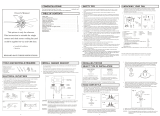
ME018-01 12/18/2015
10
Troubleshooting
Maintenance
FAN IS NOISY
1. Use of standard light rheostat or continuously variable fan speed wall control will always cause
harmonic distortions or a huming noise. Many fan motors do not work quietly with solid state variable
controls. If a quiet wall control is desired use only 3-speed NOM approved wall controls.
2. Always allow a few days of ‘break in’ time for any new fan at medium or high speed. Try to diagnose
the exact location of the noise by listening carefully from several sides (Blades, Motor, Light Kit, etc...).
3. Make sure all screws in the fan assembly are tight and properly threaded. If not, back out and
retighten. Tighten these screws at least once a year because they may loosen slowly over time and
cause a clicking noise.
4. Make sure mounting bracket is installed snugly to junction box.
5. Make sure wire nuts in switch housing or canopy are not rattling against each other or against wall of
housing. Wrap with electrical tape if necessary.
6. Make sure the canopy is not touching the ceiling.
7. Make sure that the screws fastening blade arm to motor are tight.
FAN SHAKES OR WOBBLES
1. A small amount of movement is considered acceptable and should not be considered a defect.
2. Make sure mounting bracket is tight at junction box/ceiling with no movement at all. Tighten screws if
necessary.
3. Make sure all screws holding the blades to the blade arm and blade arm to motor are tight. Make sure
light kit/glass screws are tight.
4. Some fan movement is normal. However, interchanging an adjacent (side-by-side) blade pair may
redistribute the weight and result in smooth operation.
5. Most fan wobble problems are caused when blade levels are unequal. Check this level by selecting a
point on the ceiling above the tip of one of the blades. Measure this distance. Measurements deviation
should always be within 1/8”. Rotate the fan until the next blade is positioned for measurement. Repeat
for each blade.
FAN WILL NOT START:
1. Check all fuses or circuit breakers. Replace if missing.
2. Turn off electrical power and check all wire connections to fan and in the wall control.
FAN TURNS BUT DOES NOT MOVE MUCH AIR:
1. The fan may be running in reverse, so air is directed upward.
2. The room may contain items that obstruct the air ow.
3. The fan may be too small for size of the room.
1. The fan’s natural movements may cause some connections to loosen. A clicking or rattling noise is a
certain sign of loosening screws. Check the support connections, brackets, and blade attachments twice
a year, and tighten all screws as necessary. Make sure all screws attaching the glass to the tter on the
light kit are nger tight. Do not use a screw driver or pliers to tighten glass screws.
2. Clean your fan periodically. Use only a cloth dampened with a mild detergent solution. Never use
solvents. Dust with a soft cloth or brush. Metal nishes are nished with a lacquer to prevent tarnishing
3. You will never need to oil your fan. Its permanently sealed bearings will provide silent, trouble free
operation for many years.
4. Make sure the power is turned off at the main fuse or circuit panel before you attempt any repairs.




















